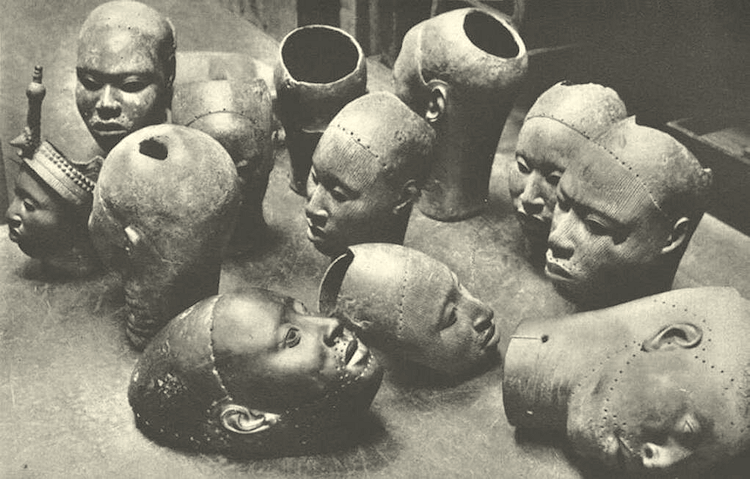The sculptural heads and the upper half of a brass figure were found by accident at the Wunmonije Compound, Ifẹ̀, during house-building. Most of the objects found in the compound and neighboring areas ended up in the National Museum of Ifẹ̀, but a few pieces were taken out of Nigeria and still remain in the collections of foreign museums. The export of these pieces spurred the colonial authorities - Nigeria was ruled by Great Britain from 1885, officially, until 1960 - to enact legislation that same year, meant to control exportation.
 |
| Four images. |
Attempting to explain the creation of these sculptures, work then thought to be extremely anomalous, Frobenius concocted a theory stating these must have been cast by a colony of ancient Greeks who had established themselves in the area in the thirteenth century BC. The claim - which was widely circulated in the press - he further expanded to hypothesize that this ancient Greek colony could very well be the origin of the legend of the lost civilization of Atlantis.
It's now recognized that these statues represent an indigenous African tradition, one that attained a very high level of realism and refinement, and the Ifẹ̀ sculptures are considered one of the greatest achievements of African culture. The naturalistic features of the Ifẹ̀ heads are unique, though, and the stylistic similarities of these works suggest that they were made by an individual artist or in a single workshop.
 |
| Two images. |























Culture decried is culture denied. Decrying that the people of Africa and other non-whites as incapable of art and culture had been going on for too long. So called experts, definitely knew better, but their racists fictions got in the way of publishing facts. How insulting for the idiot Frobenius to claim it was colonist from ancient Greece that made the sculptures instead of the Yoruba. (similar to the nazis claiming the great civilizations of Persia, Egypt and Greece were started by German 'aryans') So much for his 'expertise', would be interesting to know if others in the field of ethnography agreed or disagreed with Frobenius on his 'findings' back then.
ReplyDeleteAs for the Ife metal sculptures of the Yoruba, they are unique and beautifully rendered, and it is amazing how artistic metalworking has been used around the world going back eons. God only knows what other artistic treasures are yet to be discovered. -Rj
Trying again, with an old blog, to leave a comment. Signing in to Google didn't work.
ReplyDeleteThank you for posting these incredible photos! I'm off to look for more information. :-)
interesting article in The Guardian, 5th April 2023, about the source of the metals used for these castings ... analysis suggests much of the metal originated in Germany ... by implication, it might easily be imagined that the bronze casters were working for africans who had captured and then sold other africans into slavery
ReplyDelete